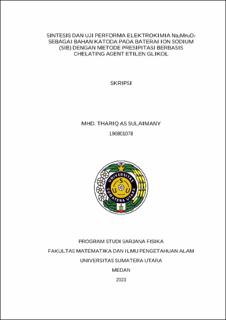| dc.description.abstract | Tests have been carried out on the electrochemical performance of NaxMnyOz as a cathode ion material in sodium ion batteries. This research aims to synthesize NaxMnyOz precursor as a cathode in sodium ion batteries. The manufacturing process uses commercial MnCO3 and synthetic MnCOx material variants. In the first sample, namely sample Tq-1, it is made from commercial MnCO3, while the second sample, namely Tq-3, is made from MnCOx which is synthesized from MnSO4.1H2O and Na2CO3. Both variants are mixed with Na2CO3 to become NaxMnyOz precursor. Next, the precursor is sintered, namely heating the material using a furnace at a temperature of 700ºC over a period of 4 hours. The precursor is then ground with a mortar and then sieved with a 400 mesh sieve to make it smooth. Make a slurry by mixing the active materials: PVDF: Super P in a ratio of 8: 1: 1 and 3.5 ml of NMP. The EIS results obtained for sample Tq-1 had a conductivity value of 3.4706 x 10-7 S/cm and Tq-3 was 2.7304 x 10-7 S/cm. In the CV test, the oxidation peak was found to be 2.77 V and the reduction peak was 1.62 V at Tq-1, and at Tq-3, the oxidation peak was 2.842 V and the reduction peak was 1.716 V. In the CD test, the maximum peak reached the Tq-1 sample. 4.3 V and a minimum of 1.4 V, while the Tq-3 sample was able to reach a maximum peak of 4.2 V and a minimum of 1.3 V. The Tq-1 capacity was 117.02 mAh/g on charge and 93. 47 mAh/g on discharge, while the Tq-3 has a capacity of 79.17 mAh/g on charge and 65.79 mAh/g on discharge. The results show that Tq-1 samples are better than Tq-3. | en_US |





